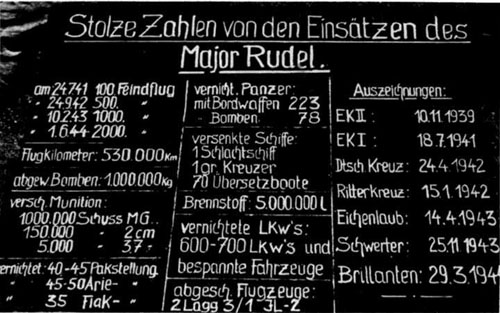Do you know why the germans would prefer to arm this aircraft with 37mm cannon instead of having bombs inside?
this aircraft was used in the east front against soviet tanks, if germany standard tank with 37mm cannon cannot beat soviet tanks, what makes an aircraft with 37mm cannon so effective? thanks
Are there any real flying Ju-87s available today?
there aren’t any Ju-87’s in flying condition that I’m awaer of and few in existence. I have seen one at the RAF Museum Hendon in London.
I suspect the ammunition used in the A/C guns may have been different from tank ammunition and the Planes could attack from any direction rather than head on which was ineffective against the sloping armour of the T-34.
But then I may be wrong.
No I thiink that you are right Wildboar. Hans_Ulrich Rudel was the Luftwaffe’s most successful tank killer ad his plane of choice was the Stuka. Given his record I think its fair to say that the 37mm was a rather successful weapon alright!
I think WildBoar makes a good point. Even though the Stuka’s were accurate bombers you get a bit more leway with a cannon. Plus you didnt always need to kill the tank. If you immobilzed the tank it would be dead soon enough. Tanks that cant move = bad
Hi, FW-190 Pilot,
You are right, from the bottom the 37mm antitank was outnumbered.
(called by German Soldiers: Panzeranklopfgerät / knocking on tankmachine). But used by an airplane it shots from the air to the upper side of the tank - and thats the most unarmed one; thats why it worked!
Rudel, by the way, carried 2 37mm (it’s Ju 87 - ofcourse) with 8 rounds each - that’s all!
Servus
i think the 37mm was able to panetrate T-34 because of gravity pull when the plane dive!!! :lol:
Hi, A.H.,
I’m sorry, but that’s real nonsense. The upper side of any tank, even a modern one, is the most unarmoured - that’s why it worked!
By the way, old boy, I would prefer if You would change Your nickname - it’s nothing but a silly joke - sorry!
Salve
Easier to aim and hit with, and lighter (high velocity makes up for low explosive charge) so allowing more tanks to be attacked per sortie.
I think it’s been said before but it could penetrate on the upper armor, it could break the tracks down and bring down more tanks per sorties (like the last guy said)
Gravity will have very little effect on that. The plane diving will help!
The armour on top of a tank is much thinner than the front and sides, hence using a dive bomber to attack the top.
They didn’t use bombs because they weren’t accurate enough to hit a moving tank whereas with a cannon you have more tha one chance to hit them.
They didnt dive onto the target, it was a shallow dive from about 5-600 meters. The reason that they 37mm was so effective was that the tanks were attacked from the rear where the armour was thinniest around the engine compartment. I would say that track attacks were out at 2-300 kmh. Still took skill to do, the henschell (SP) was designed specifically for this purpose and the Sturmovik was good at it too against all German armour.
Do you know why the germans would prefer to arm this aircraft with 37mm cannon instead of having bombs inside?
this aircraft was used in the east front against soviet tanks, if germany standard tank with 37mm cannon cannot beat soviet tanks, what makes an aircraft with 37mm cannon so effective? thanks
Because is far more accurate than bombs.
The BordKanone Bk 3,7 had a very high muzzle velocity and a tugsten core bullets, it can penetrate most of the russian tanks.

Hans Rudel splattered plenty of Sov armor by maneuvering around for engine shots from the back of the tank. That’s whay he did anyhow. The cannon gives multiple opportunities for kills simply because it has several rounds to fire whereas a bomb is one shot.

Hans Ulrich Rudel Kills after his 2000th mision, very impressive :shock:

As you can see at the time, mid 1944, this pilot claimed 301 tanks, 228 with canon fire.
An excelent site about this guy.
http://www.pilotenbunker.de/Stuka/Rudel/rudel.htm
Well I think we’ve pretty much answered that how about this!!!
from http://www.unrealaircraft.com/qbranch/junkers_j87.php
During World War 2, development of clandestine operations almost inevitably led to delivery of agents behind enemy lines by air, either by landing them or dropping them by parachute.
Both sides toyed with the idea of dropping their agents in self-contained units carried, for example, under the fuselage in something looking like a drop fuel tank. The British tended to airdrop agents from transports or special operations bombers, or deliver and extract them by way of the Westland Lysander (right, bottom).
Germany developed the idea using the Junkers Ju.87, best known in its role as a ground attack aircraft, the Stuka. The overwing passenger pods tried on the Ju.87D-3 were the ultimate expression of the concept, making the pods almost an integral part of the aircraft. Each pod could carry two passengers. They were designed to be released whilst the aircraft was in a shallow dive, descending on a huge parachute.

Two words… Screw that!!!
Also try
Video of Junkers Ju-87G-2 strafing tanks in Hungary:
